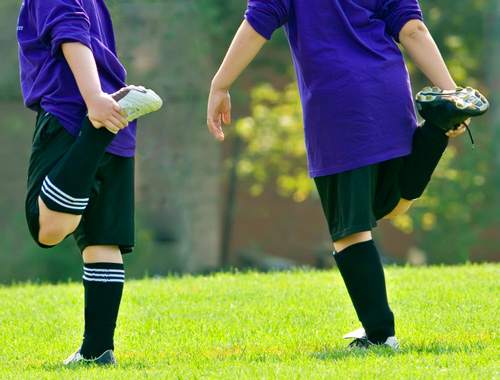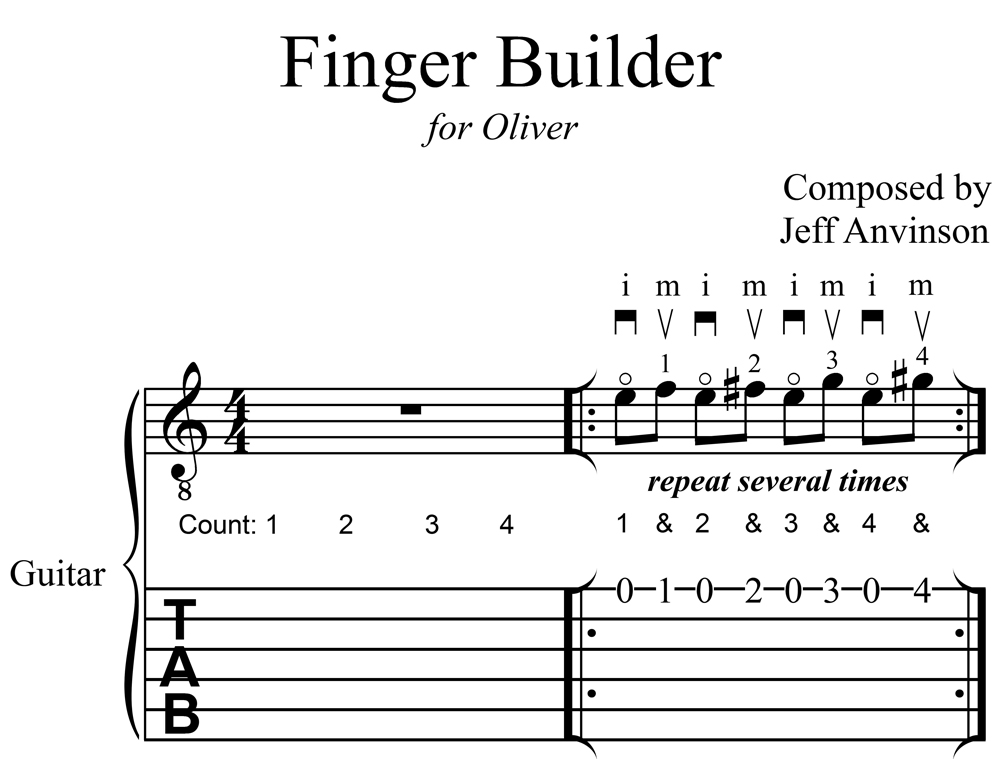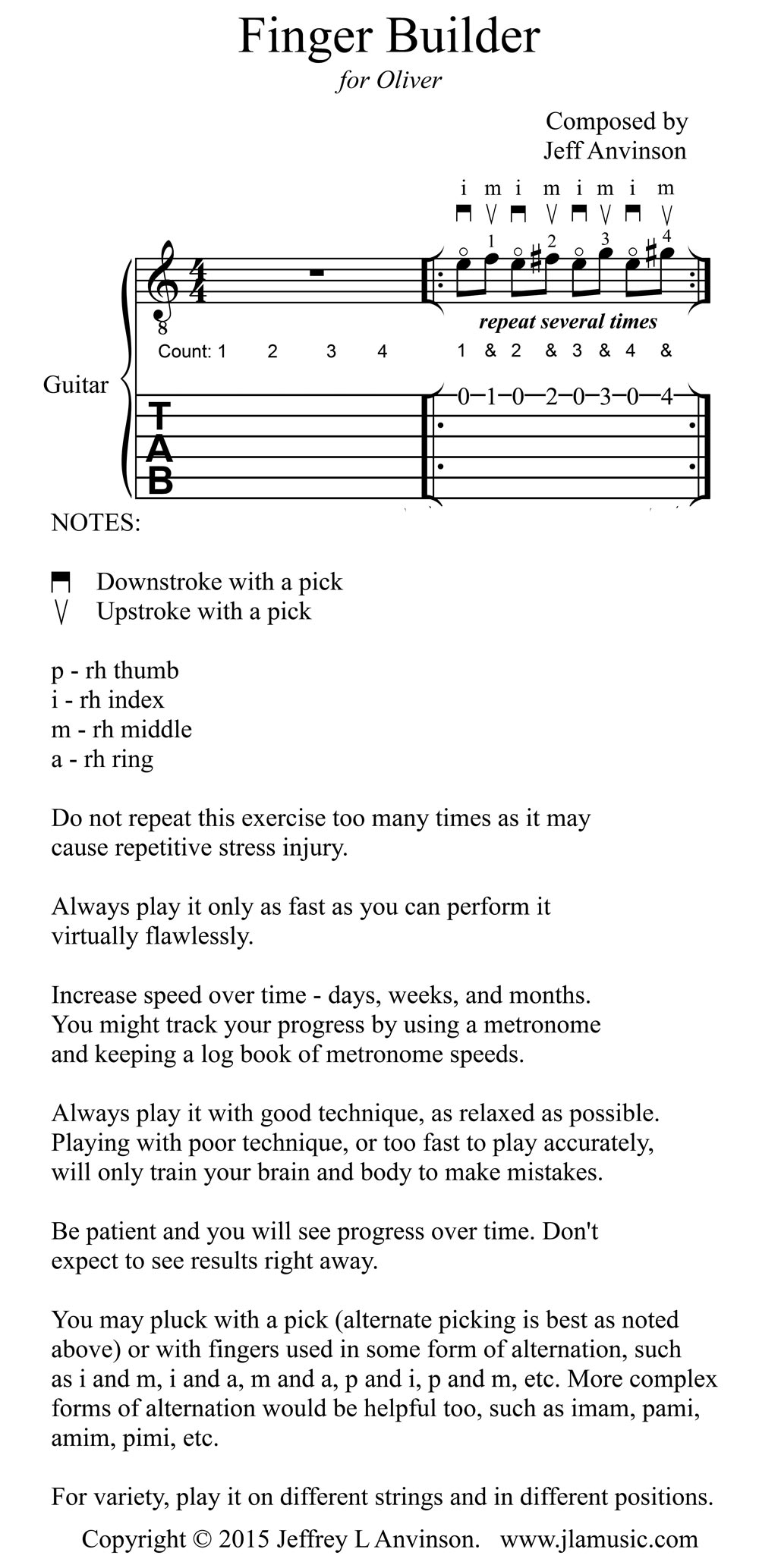What Do Soccer and Guitar Playing Have in Common?: A Soccer-Inspired Guitar Exercise Called "Finger Builder"

One of my young students came to his guitar lesson and told me that he was playing soccer. I was intrigued - and thought back to my youth when I played sports for a time - when he described various drills that his coach put him and his teammates through to develop endurance, speed, and other characteristics of a good team. Many of these drills had fancy names such as "Man Builder" and other evocative titles. He described one exercise where he would run a short distance then return to the starting point, then run about twice as long, again returning to the starting point. Each repetition involved longer distances. He gave me the impression that though he didn't find these repetitive exercises as fun as playing soccer, he knew that they were crucial for developing various skills in order to play soccer well.
As my student talked about these athletic exercises, and I noted his ready acceptance of them despite their somewhat boring and challenging nature, I thought of how I could motivate him to play similar exercises on the guitar. So, on the spot, I made up an exercise, played it for him, and asked what he thought it should be called. After some thought, he said, "Finger Builder". He was quite enthused about the idea of learning various exercises, perhaps one per week, just like he was accepting his soccer coach's drills.
Many serious musicians practice exercises to develop specific skills that they can use to perform music better. Many composers have written pieces called "Etudes" that attempt to develop particular skills while functioning as bona fide concert works. There are many etudes written for the guitar by composers such as Sor, Giuliani, Villa Lobos, and Coste. Virtually every traditional instrument has a set of etudes devoted to it. For the piano, the etudes of Chopin come to mind.
Finger Builder Exercise
Displayed below in both a short form and a longer form is "Finger Builder". If you are unfamiliar with the symbols in the sheet music, take a look at the longer page below for a description of them. Before you play it, make note of the following suggestions.
- If you play along with an audio clip remember to count one measure of rest. Count "1", "2", "3", "4" before you start playing. You will hear a woodblock sound during the measure of rest and while you're playing the repeated measure. With the slowest audio clips the beat is very slow so it will be a little difficult to "feel" the tempo. Playing it a second will help you with this problem.
- Make sure to follow the fretting hand fingering, using all four fingers.
- Your fretting hand fingers should land on the tips, with extended joints, in close proximity to the fret wires to the sound hole side of the frets. A collection of videos showing the fretting hand in action are found on this website: http://jlamusic.com/Learn/guitarhandvideos/guitarhandvideosmainpage.html
- The palm of the fretting hand should move very little and maintain a position relatively parallel to the fingerboard. It should also be relatively close to the edge of the fingerboard.
- Make sure that your body position is good with your fretting hand wrist in a neutral position, with very little flexing or extension.
- IMPORTANT: Do not repeat this exercise too many times, especially when it's done daily for weeks or months at a time, as it may cause repetitive stress injury.
- Always play it only as fast as you can perform it virtually flawlessly.
- Increase speed over time - days, weeks, and months. You might track your progress by using a metronome and keeping a log book of metronome speeds. You can use the many audio clips below to gauge your progress as well.
- Always play it with good technique, as relaxed as possible. Playing with poor technique, or too fast to play accurately, will only train your brain and body to make mistakes.
Paradoxically, the fastest way to build speed and precision is to start slowly and accurately while gradually building speed over weeks and months.
- Be patient and you will see progress over time. Don't expect to see results right away.
- You may pluck with a pick (alternate picking is best as noted in the music) or with fingers using some form of alternation, such as i and m, i and a, m and a, p and i, p and m, etc. More complex forms of alternation would be helpful too, such as imam, pami, amim, pimi, etc.
- For variety, play it on different strings and in different positions.
- You may want to read my web article about practicing found here.
- Find or create additional exercises that build speed.
- Adapt the exercise to focus on different fretting hand fingers. The adapted example below uses only the ring and little fingers to fret the notes (3, 4, 3, 4). Note: You may want to repeat this fewer times at first to avoid a repetitive stress injury. Let your weaker fingers build strength and endurance gradually.

Audio Clips to Gauge Your Progress
I have included lots of audio clips below that you can play along with while you work on this exercise. (The one-measure exercise is played twice on the audio clips.) The first audio clip is quite slow for an absolute beginner. Each subsequent clip is 10 beats per minute faster so that you can gradually increase guitar-playing speed. They are grouped into arbitrary levels of difficulty, roughly equal to beginner, intermediate, and advanced. (There is also an insane one at 1,000 beats per minute just for fun.) While you do the drills, you might pretend you are a soccer player on a pro team. After all, athletics and music both involve the use of muscles: athletes tend to use bigger muscles while musicians tend to use smaller ones. On second thought, perhaps it would be better to imagine yourself as a Rock star. :-)
I hope you have fun playing "Finger Builder" while you improve your technique and velocity.
Jeff Anvinson, owner/operator of JLA Music
Click here to get a pdf version of the long version shown at the bottom of this page. Please don't distribute this pdf by photocopying or posting it on the internet. You may print out one copy for your own use. If you know someone who wants a copy, simply refer them to this website. Please help me protect my intellectual property by respecting my rights.

Audio Clips
NOTE: Sometimes the audio clips don't play correctly the first time.
Simply playing them a second time solves this problem.
Level 1
30 beats per minute
40 beats per minute
50 beats per minute
60 beats per minute
70 beats per minute
80 beats per minute
90 beats per minute
100 beats per minute
120 beats per minute
130 beats per minute
140 beats per minute
150 beats per minute
Level 2
160 beats per minute
170 beats per minute
180 beats per minute
190 beats per minute
200 beats per minute
210 beats per minute
220 beats per minute
230 beats per minute
240 beats per minute
250 beats per minute
260 beats per minute
270 beats per minute
280 beats per minute
Level 3
290 beats per minute
300 beats per minute
310 beats per minute
320 beats per minute
330 beats per minute
340 beats per minute
350 beats per minute
360 beats per minute
370 beats per minute
380 beats per minute
390 beats per minute
400 beats per minute
410 beats per minute
Level of Insanity
1,000 beats per minute

Website and most graphics are created inhouse by Jeff Anvinson, Owner/Operator of JLA Music
Some graphics are purchased from Can Stock Photo, used by permission, and are Copyright
© Can Stock Photo
JLA Music takes care not to infringe on anyone's rights. Please contact us at jla@jlamusic.com if you have questions.
Copyright 2023 © Jeffrey L Anvinson




